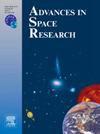Spatiotemporal evolution of ecosystem carbon storage under land use/land cover dynamics in the coastal region of Central Vietnam
IF 2.8
3区 地球科学
Q2 ASTRONOMY & ASTROPHYSICS
引用次数: 0
Abstract
Ecosystem carbon storage is a cost-effective strategy for global climate change mitigation, and its fluctuation is markedly shaped by land use/land cover (LULC) dynamics. Taking Danang city as an example of Central Coastal Vietnam, this study aims to assess LULC changes and analyze the spatiotemporal evolution of carbon storage from 2023 to 2050 under four LULC change scenarios, including natural trend scenario (NTS), ecological protection scenario (EPS), economic development scenario (EDS), and cropland protection scenario (CPS), by integrating the support vector machine-cellular automata-Markov (SVM-CA-Markov) model and the InVEST model. The Optimal Parameters-based Geographical Detector (OPGD) model was subsequently employed to elucidate the impacts of driving factors on the spatial distribution of carbon storage. The results showed that, from 2007 to 2023, Danang city experienced a dramatic back-and-forth transformation between LULC types, with the predominant transitions being from natural forest to acacia tree-dominated plantation forest (6492.31 ha), and from cropland to settlements, acacia tree-dominated plantation forest, and other land (5483.05 ha, 3763.66 ha, 2762.35 ha, respectively). Between 2023 and 2050, LULC transformations in Danang city are projected to yield varying degrees of carbon storage levels across different scenarios. Specifically, carbon storage is anticipated to dwindle by 0.221 Mt, 0.223 Mt, and 0.298 Mt under NTS, EDS, and CPS, respectively, while enhancing by 0.141 Mt under EPS. Regarding the spatial distribution of carbon storage, high values will be chiefly found in the western high-elevation mountainous region, while low values will be concentrated mostly in the eastern lower-lying areas of the city. Additionally, elevation and temperature acted as the two most significant driving factors influencing the spatial distribution of carbon storage, with Q values of 0.88 and 0.86 (p-value < 0.05), respectively. For interaction detection, the combination of elevation and soil exhibited a synergistic reinforcement effect on the spatial partitioning of carbon storage, with a high Q value of 0.9566 (p-value < 0.05). Our study highlights the necessity of ecological conservation measures in Danang city in the on-track pursuit of national net-zero carbon emissions by 2050.
越南中部沿海地区土地利用/土地覆盖动态下生态系统碳储量的时空演变
生态系统碳储量是一种具有成本效益的全球气候变化减缓战略,其波动明显受到土地利用/土地覆盖动态的影响。基于支持向量机-元细胞自动机-马尔可夫(SVM-CA-Markov)模型和InVEST模型,以越南中部沿海城市岘港市为例,在自然趋势情景(NTS)、生态保护情景(EPS)、经济发展情景(EDS)和耕地保护情景(CPS) 4种情景下,评估了岘港市2023 - 2050年的土地利用碳储量变化,分析了土地利用碳储量的时空演变。采用基于最优参数的地理探测器(OPGD)模型分析驱动因素对碳储量空间分布的影响。结果表明:2007 - 2023年,岘港市土地利用利用资源类型发生了明显的交替变化,以天然林向金合欢人工林(6492.31 ha)、耕地向聚落、金合欢人工林和其他土地(5483.05 ha、3763.66 ha、2762.35 ha)为主。预计在2023年至2050年期间,岘港市的LULC转换将在不同情景下产生不同程度的碳储存水平。具体而言,碳储量预计在NTS、EDS和CPS下分别减少0.221 Mt、0.223 Mt和0.298 Mt,而在EPS下增加0.141 Mt。从碳储量的空间分布来看,高值区主要集中在西部高海拔山区,低值区主要集中在东部低海拔地区。海拔和温度是影响碳储量空间分布最显著的两个驱动因子,其Q值分别为0.88和0.86 (p值<; 0.05)。在互作检测中,海拔与土壤的组合对碳储量的空间分区表现出协同强化效应,Q值较高,为0.9566 (p值<; 0.05)。我们的研究强调了岘港市在2050年实现全国净零碳排放的轨道上采取生态保护措施的必要性。
本文章由计算机程序翻译,如有差异,请以英文原文为准。
求助全文
约1分钟内获得全文
求助全文
来源期刊

Advances in Space Research
地学天文-地球科学综合
CiteScore
5.20
自引率
11.50%
发文量
800
审稿时长
5.8 months
期刊介绍:
The COSPAR publication Advances in Space Research (ASR) is an open journal covering all areas of space research including: space studies of the Earth''s surface, meteorology, climate, the Earth-Moon system, planets and small bodies of the solar system, upper atmospheres, ionospheres and magnetospheres of the Earth and planets including reference atmospheres, space plasmas in the solar system, astrophysics from space, materials sciences in space, fundamental physics in space, space debris, space weather, Earth observations of space phenomena, etc.
NB: Please note that manuscripts related to life sciences as related to space are no more accepted for submission to Advances in Space Research. Such manuscripts should now be submitted to the new COSPAR Journal Life Sciences in Space Research (LSSR).
All submissions are reviewed by two scientists in the field. COSPAR is an interdisciplinary scientific organization concerned with the progress of space research on an international scale. Operating under the rules of ICSU, COSPAR ignores political considerations and considers all questions solely from the scientific viewpoint.
 求助内容:
求助内容: 应助结果提醒方式:
应助结果提醒方式:


